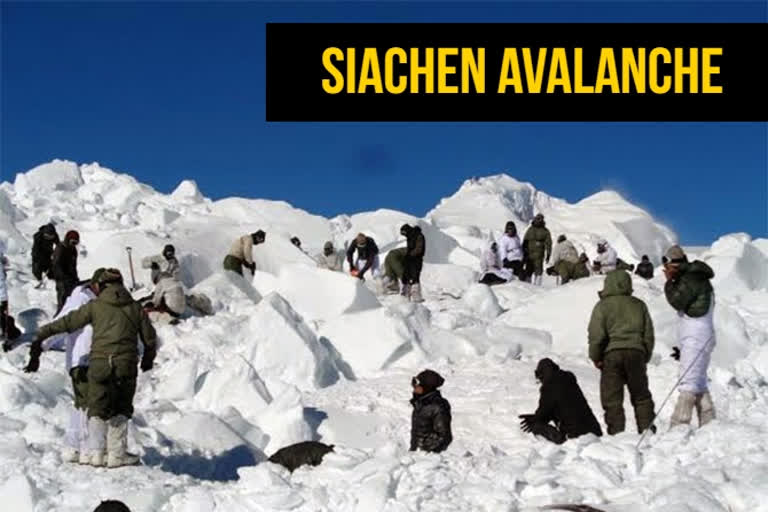New Delhi: Nature is at its cruellest for man at the unforgiving terrain of the world’s highest battleground! The Bana Top post at Siachen, the second largest glacier in the world after the polar region, is virtually a death zone with scarce oxygen and controlling the zone comes at a heavy cost of men and resources.
It is somewhere near this post, at about 20000 feet, that the heavy winter ice and accumulated snow gave away and an ice wall came crashing down on an Indian Army team of eight soldiers, who were on a routine patrol on Monday.
It may be a place where ‘not a blade of grass grows’, but the Bana Top accords a clear overview of the Saltoro Ridge and the Siachen glacier - and it doesn’t take a military man to understand the immense tactical value of such a post. Nor in the least, because this is the area is one of the biggest freshwater reserves of the country.
That is why the Bana Post, at more than 21,000 feet, is remembered with pride after the valorous exploits of Subedar Major and Honorary Captain Bana Singh who led a small team up a 1,500 feet high sheer ice wall to claim the spot from the Pakistanis after a bloody fight on June 26, 1987.
An emergency rescue using trained men, sniffer dogs, high altitude equipment and military helicopters that were pressed into service was to be in vain despite the best efforts. While the men buried under heavy snow were pulled out and given medical treatment, the freezing temperatures, and high altitude hazards had taken their toll. Four army jawans and two civilian porters lost their lives.
On Tuesday, Defence Minister Rajnath Singh spoke to Army chief General Bipin Rawat from Singapore where the minister is on an official visit to inquire about the Siachen incident even as he tweeted his condolence- “Deeply pained by the demise of soldiers and porters due to avalanche in Siachen. I salute their courage and service to the nation. My heartfelt condolences to their families.”
Also read: Defence minister condoles deaths of Army personnel, porters in Siachen
In February 2016, 10 Indian soldiers from the Madras Regiment’s 19 battalion, were buried in an avalanche at Siachen. Only Lance Naik Hanumanthappa, 33, was dug out from 30 feet deep snow after he miraculously survived for five days although he later succumbed to his injuries in a Delhi hospital after being airlifted to the national capital. Just a month before that, another four soldiers had lost their lives in an avalanche in Siachen.
In 34 years from 1984 to 2018, 869 Indian soldiers have lost their lives in Siachen due to factors other than combat.
On April 7, 2012, in one of the most devastating avalanches in the region, about 135 Pakistani soldiers died after being buried under tons of snow after an avalanche hit them near Siachen.
It is believed that the frequency of avalanches has been growing in the upper reaches of the Himalayas in the last three decades and many experts have attributed it to the forces of global warming as rising temperatures cause the ice to crack more easily leading to avalanches particularly after snowstorms.
Meanwhile, the Indian Army will pay homage on Wednesday to the four soldiers who were killed in an avalanche in Siachen before handing over their bodies to their families.
"The Army personnel killed in the Siachen avalanche include Sep Manish Kumar, Veerpal Singh, Dimpal Kumar, and Maninder Singh. Their bodies would be flown out of Ladakh tomorrow in an Air Force aircraft after the local units pay respect to them," Army officials said.
The four soldiers include three from Punjab regiment while one belongs to the Dogra regiment of the Army. While the three personnel of Punjab regiment are residents of Punjab, the soldier belonging to Dogra regiment hails from Solan, Himachal Pradesh.
Apart from the four soldiers, two porters were also killed in the avalanche that hit the northern glacier on Monday.
Also read: Indian Army felicitated for keeping Siachen glacier tidy



